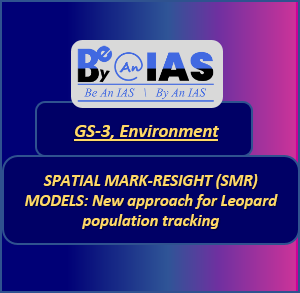CURRENT AFFAIRS
Get the most updated and recent current affair content on Padhaikaro.com
SPATIAL MARK-RESIGHT (SMR) MODELS: New approach for Leopard population tracking
- Be N By IAS, Delhi
- 17, Feb 2021

For : GS-3-Environment
CONTEXT:
- Scientists from Aaranyak, Panthera, and WWF-India have developed a model called ‘Spatial Mark-Resight’ (SMR) to precisely estimate the population size in areas sustaining a mix of rosette and melanistic individuals.
- Among the wild cats, melanism has been documented in only 14 out of the 40 species found globally.

NEED OF NEW MODEL:
- Wildlife specialists have for long faced challenges estimating the density of leopards in areas where some of the spotted cats are melanistic or black.
- Rosettes leopards: They are jagged black circular marks on the tawny coat of a leopard. Like the tiger’s stripes, the rosettes of each leopard are unique in shape and size, making the species identifiable individually.
- Melanistic leopards — commonly called black leopards or black panthers or ghongs (Assamese) — have been difficult to estimate as their rosettes are invisible.
- Unlike rosette leopards, a black leopard can often not be reliably identified individually, although special cases exist. Therefore, difficult to completely estimate population sizes of leopards.
SPATIAL MARK-RESIGHT (SMR) MODELS:
- The Spatial Mark-Resight (SMR) models have provided a way of counting the melanistic leopards too.
- When a population has only rosette leopard, estimating their population size becomes easy because all the individuals can be identified.
- Apply camera trapping field method: The SMR method is expected to make it easier to assess the population status of leopards for informed conservation measures by applying the conventional camera trapping field method.
- For Other Species as well: It can also be widely applied for other species that exhibit similar colour variation in nature, the wild cat specialists said.
- “In the SMR models, we then borrow the capture history of the rosette leopards and apply the information on the melanistic leopards to estimate the entire population size of leopards. This is a significant analytical development that can help assess the population of leopards across a great part of the species range from where population estimates are scant
‘ACUTE PROBLEM’
- Forest of South Asia: “This problem is acute in the tropical and subtropical moist forests of South and Southeast Asia where the frequency of melanistic leopards is high.
- No precise estimation in India so far: Here leopards also face the greatest threat. No precise estimates of leopard population could thus be done in protected areas and non-protected areas in India except on some occasions.”
- Scientists used three years of camera trapping data between 2017 and 2019 obtained from Manas National Park to establish the SMR approach.
- >20% Melanistic leopards: The population density of leopards in Manas is 3.37 per 100 sq km. In the study, about 22.6% images of the leopards were of the melanistic kind.
PANTHERA ORGANISATION:
- U.S.-based Panthera is the only organisation in the world devoted exclusively to the conservation of the world’s 40 wild cat species and their ecosystems.
- It was founded in 2006.
- Panthera focuses its efforts on conservation of the world's largest, most imperiled cats: tigers, lions, jaguars and snow leopards, and also developing conservation programs for cheetahs, leopards and cougars.
- The organization has offices in New York City and London.
SOURCE: The Hindu
MCQs:
Q. Consider the following statements about Spatial Mark-Resight (SMR) models.
- It has provided a way of counting only for the Rosettes leopards and not for melanistic leopards.
- When a population has only rosette leopard, estimating their population size becomes easy because all the individuals can be identified.
- It can also be widely applied for other species that exhibit similar colour variation in nature.
Which of the above statements is/are correct?
- a) 1 and 2 Only
- b) 2 and 3 Only
- c) 1 and 3 Only
- d) 1, 2 and 3
ANS: B